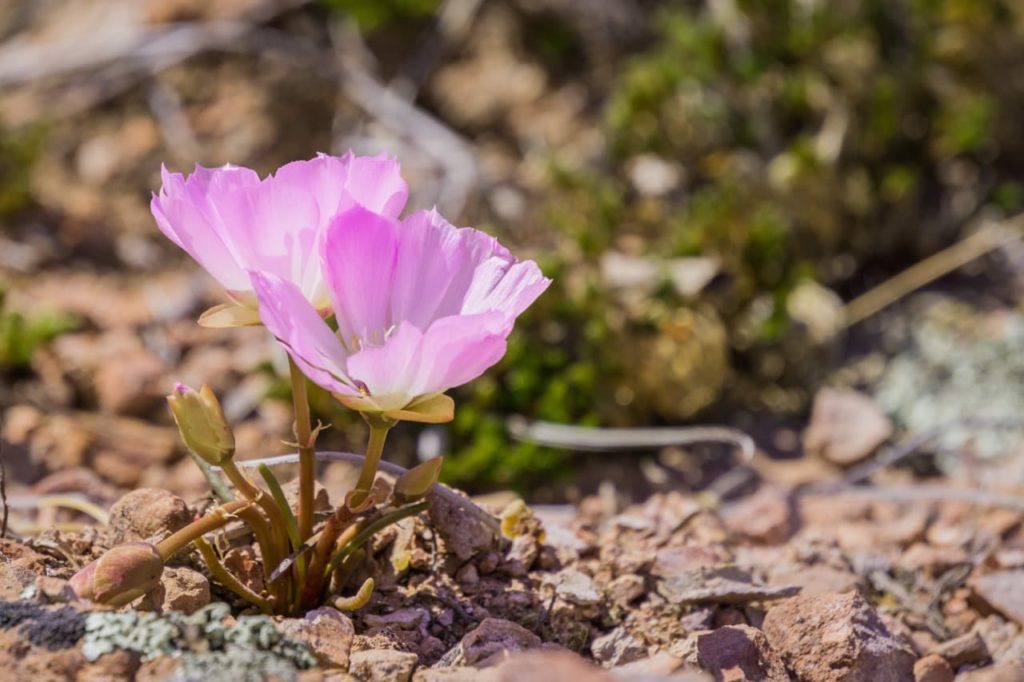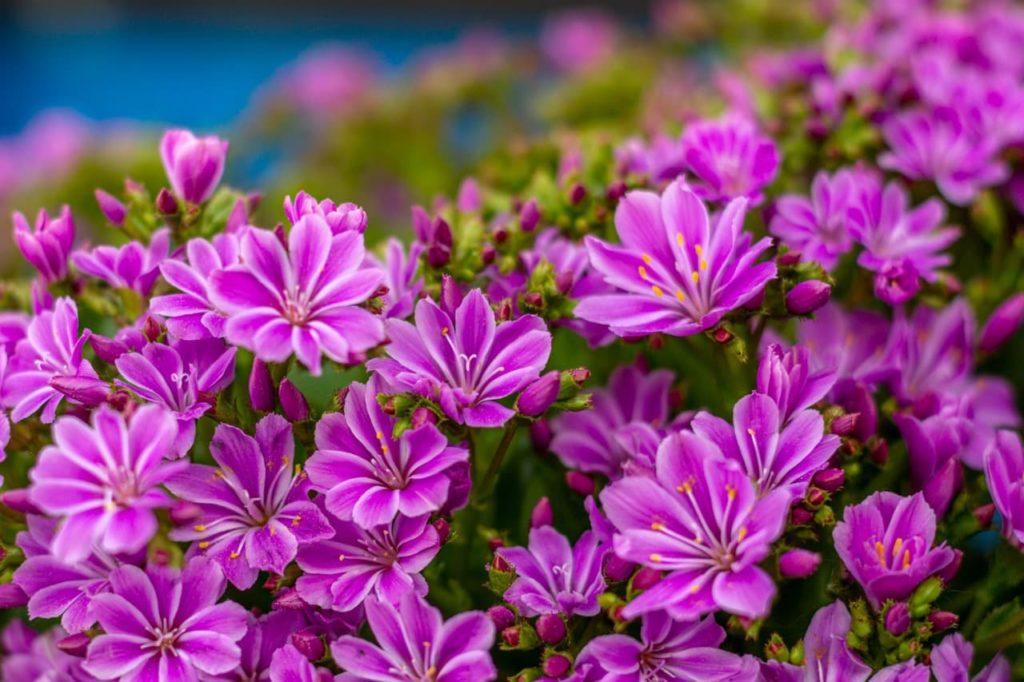ALPINES > LEWISIA
Reviewed By COLIN SKELLY

Colin is a Horticulturist and Horticultural Consultant with experience in a range of practical and managerial roles across heritage, commercial and public horticulture. He holds the Royal Horticultural Society’s Master of Horticulture award and has a particular interest in horticultural ecology and naturalistic planting for habitat and climate resilience.
From the neatest little rosette of ribbon-like leaves emerge taller flowering stalks on Lewisia, a compact evergreen, and what pretty flowers those stalks hold!
These flowers feature little star-like blooms with silken petals in tones of pink, purple and orange, with elegant streaks and flushes across the petals.
Lewisias produce a profusion of delightful, small, funnel-shaped, star-like flowers with silken petals in radiant hues, each petal displaying longitudinal streaks, bands, flushes or other colouration.
Overview
| Botanical Name | Lewisia |
| Common Name(s) | Bitter Root / Cliff Maid |
| Plant Type | Alpine / Perennial |
| Native Area | Northwest America |
| Hardiness Rating | H4 |
| Foliage | Deciduous / semi-evergreen / evergreen |
| Flowers | Star-like and marginally funnel-shaped with 8-10 petals in various colours from white to red |
| When To Plant | June |
Sunlight
Preferred
Full sun
Exposure
Exposed or sheltered
Size
Height
0.1 – 0.3M
Spread
0.1 – 0.4M
Bloom Time
May to September
Soil
Preferred
Sand or chalk
Moisture
Well-drained
pH
Acidic
Though these blooms truly have a graceful, refined look about them, no-fuss Lewisia grows in hardscrabble habitats which means that you don’t need to worry yourself too much about fertile soil, feeding, or even watering.1Lewisia cotyledon. (n.d.). Lady Bird Johnson Wildflower Center – University of Texas at Austin. Retrieved August 3, 2023, from https://www.wildflower.org/plants/result.php?id_plant=LECO5

You can take advantage of this fact and the plant’s small size to bring pebbly, sandy patches to life and to fill odd crevices and holes in or on walls.
The plant also has a tidy habit quite like lilies, as the ribbon and strap-like leaves, from narrow to broad, grow in a neat rosette over which taller stalks exhibit those appealing little blooms.
Plant these versatile little perennials in a bed, pot, rockery or crevice.
How To Grow Lewisia
Lewisias must have very well-draining soil that is somewhat fertile, though not overly-rich for the best results.
Take a base of gravel, grit and sand and amend it with humus and ericaceous organic compost in a very conservative ratio, and you’ll have the ideal medium for this plant.

If any of the first three components are in short supply, add perlite instead.
For such plants, I lay pebbles at the bottom-most layer to be certain that subsided water drains.
I would also make a top layer of pebbles and gravel; this will suit this plant very well as it will offer protection from crown rot.
Light
Lewisia should be positioned in full sun, especially in the UK, for optimal health and flowering.
Planting
First off, Lewisias must be protected from wet conditions in the winter.
Also, they are very compact and their habit and form make them perfect for standard half-conical pots.
So, if you plant Lewisias in pots, they are virtually winter-proofed already, as you can shift pots to somewhere they will have a roof over their heads, such as a porch or covered patio.
“I treat Lewisia like succulents as they have the same tolerance of dry spells and susceptibility to wet root conditions,” shares Colin Skelly, a Horticultural Consultant.
“Soil in pots can easily be adapted to reflect the free-draining, alpine conditions Lewisia evolved in.”
As for open-ground planting, this may be done sometime after the last frost and after the soil has warmed up.

May is ideal.
When transplanting, make certain that only the root crown is below the soil as you backfill the hole.
Also, set the plant at the same level it was in the pot and no lower.
If you plant Lewisias in crevices and holes in walls, make sure to add some ericaceous compost to the medium you prepare just in case the native medium is too lime-centric and alkaline.
Lewisia Plant Care
Watering
Young and growing Lewisia plants must be watered regularly during the growing season, particularly in spring and autumn.
During spring, water twice a week depending on the weather, but make sure that excess water can always drain away.
Established Lewisias are actually drought-tolerant, so mature plants will not be unduly affected if a couple of watering sessions are missed.
In fact, underwatering will not harm Lewisias, but overwatering will.
Water needs are greatly reduced during the winter and during summer dormancy.
Feeding
Lewisias do not need to be fertilised, so that’s another gardening chore you can disregard.

Of course, they will perform better if they are fertilised correctly, but over-fertilising will injure or even kill these plants.
Feed monthly from April to July, diluting the fertiliser to only about 25-30% of the recommended strength and volume.
Pour the solution away from the crown and water it in.
Deadheading
You may deadhead spent blooms on a continuing basis to encourage fresh blooms and prolong flowering.
Propagation
Lewisia is not exactly easy to grow from seed and can take anything from one month to one year to germinate.
If you wish to germinate seeds indoors in autumn, they will have to be stratified by being subjected to a cold period.
Seeds should be placed in the fridge for a couple of months and then directly sown in spring.

Sow densely in a seed-starting mix amended with sharp sand.
Simply nudge seeds into the medium. Do not cover them.
Keep the medium continuously moist until germination.
As Lewisias produce offsets over time, you can also propagate them this way and it is more convenient and easier than sowing and germinating those fussy seeds.
Any time in June, simply dig up an offset without disturbing the mother plant, cleanly slicing through any subsoil tissue that may connect the plant and the offset.
Replant the offset in exactly the same type of soil and to the same depth and water it in.
Common Problems
The main pests that can affect Lewisias are snails, slugs and aphids.

Although aphids can become a serious concern if not tackled early on, none of these three pests are too difficult to control.
The real problem with Lewisias is their susceptibility to root and crown rot, which is usually caused by human error.
These conditions are hard to detect in their early stages and often result in the death of the plant.
Prevent these diseases in the first place by paying attention to the growing medium and watering practices and by guarding against winter wet.
Commonly Grown Types
L. tweedyi

Produces relatively large flowers at 4-6cm wide that are in restrained, delicate shades of yellow, peach, cream and white, with petals showing fine longitudinal gradations.
The plant is about 20cm tall and is another RHS Award of Garden Merit winner.
L. cotyledon Sunset Group

Grows to about 20cm tall with a slightly greater spread, producing flowers that are 2-2.5cm wide.
They occur in tones of orange, yellow and red, whilst the petals display very fine longitudinal gradation and banding.
This is a recipient of the RHS Award of Garden Merit.
L. pygmaea

As its name indicates, this is the baby of the family and has a height and spread of under 10cm!
Its flowers are only about 1.5cm wide and occur in rich tones of pink, purple and red.
L. ‘Little Mango’
Grows to about 12cm tall with a slightly bigger spread.
The relatively large flowers are a rich tone of yellow.
Lewisia cotyledon ‘Elise Mix’

A cracking new cultivar which is popular for good reason, as it starts blooming before and continues after summer, with the longest blooming season among Lewisias.
The colours include yellows, pinks, reds and oranges in fruity tones with petals decorated with striping and picotee.
This cultivar grows to about 25cm tall with a slightly bigger spread.
References
- 1Lewisia cotyledon. (n.d.). Lady Bird Johnson Wildflower Center – University of Texas at Austin. Retrieved August 3, 2023, from https://www.wildflower.org/plants/result.php?id_plant=LECO5


